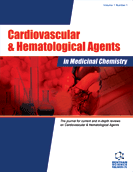Abstract
Background: There are data indicating that several azonine-derivatives may exert effects on some biological systems; however, there is very low information on the biological activity induced by these compounds on left ventricular pressure.
Objective: The aim of this study was to synthesize and evaluate the biological activity of new triazoninederivative on left ventricular pressure. Material and Methods: The first stage involved: 1) preparation of two azepine-benzamide derivatives (Z or E) by reaction of the nitrobenzoyl azide with adrenosterone; and 2) reaction of (Z)-azepine-benzamide derivative with ethylenediamine to form the triazonine derivative. The structure of compounds was confirmed by spectroscopy and spectrometry data. The second stage involved the biologic activity on left ventricular pressure was evaluated in a model of rat heart isolated. In addition, some physicochemical parameters were evaluated to characterize the possible molecules involved in its effect. Results: The results showed that only the triazonine increased left ventricular pressure via androgen receptor. Conclusions: In conclusion, this phenomenon is conditioned by the functional groups involved in the chemical structure of triazonine derivative and their interaction with residues of amino acids involved on the androgen receptor surface.Keywords: Adrenosterone, androgen receptor, benzamide, ethylenediamine, triazonine derivative, ventricular pressure
Graphical Abstract
Cardiovascular & Hematological Agents in Medicinal Chemistry
Title:Experimental, Theoretical and Biological Activity of a Triazonine- Derivative on Left Ventricular Pressure
Volume: 14 Issue: 2
Author(s): Lauro Figueroa-Valverde, Maria Lopez-Ramos, Marcela Rosas-Nexticapa, Socorro Herrera-Meza, Francisco Diaz-Cedillo, Elodia Garcia-Cervera, Eduardo Pool-Gomez, Tania Garcia-Camacho and Angel Aguilar-Villarino
Affiliation:
Keywords: Adrenosterone, androgen receptor, benzamide, ethylenediamine, triazonine derivative, ventricular pressure
Abstract: Background: There are data indicating that several azonine-derivatives may exert effects on some biological systems; however, there is very low information on the biological activity induced by these compounds on left ventricular pressure.
Objective: The aim of this study was to synthesize and evaluate the biological activity of new triazoninederivative on left ventricular pressure. Material and Methods: The first stage involved: 1) preparation of two azepine-benzamide derivatives (Z or E) by reaction of the nitrobenzoyl azide with adrenosterone; and 2) reaction of (Z)-azepine-benzamide derivative with ethylenediamine to form the triazonine derivative. The structure of compounds was confirmed by spectroscopy and spectrometry data. The second stage involved the biologic activity on left ventricular pressure was evaluated in a model of rat heart isolated. In addition, some physicochemical parameters were evaluated to characterize the possible molecules involved in its effect. Results: The results showed that only the triazonine increased left ventricular pressure via androgen receptor. Conclusions: In conclusion, this phenomenon is conditioned by the functional groups involved in the chemical structure of triazonine derivative and their interaction with residues of amino acids involved on the androgen receptor surface.Export Options
About this article
Cite this article as:
Figueroa-Valverde Lauro, Lopez-Ramos Maria, Rosas-Nexticapa Marcela, Herrera-Meza Socorro, Diaz-Cedillo Francisco, Garcia-Cervera Elodia, Pool-Gomez Eduardo, Garcia-Camacho Tania and Aguilar-Villarino Angel, Experimental, Theoretical and Biological Activity of a Triazonine- Derivative on Left Ventricular Pressure, Cardiovascular & Hematological Agents in Medicinal Chemistry 2016; 14 (2) . https://dx.doi.org/10.2174/1871525715666161123115308
| DOI https://dx.doi.org/10.2174/1871525715666161123115308 |
Print ISSN 1871-5257 |
| Publisher Name Bentham Science Publisher |
Online ISSN 1875-6182 |
 36
36 1
1
- Author Guidelines
- Bentham Author Support Services (BASS)
- Graphical Abstracts
- Fabricating and Stating False Information
- Research Misconduct
- Post Publication Discussions and Corrections
- Publishing Ethics and Rectitude
- Increase Visibility of Your Article
- Archiving Policies
- Peer Review Workflow
- Order Your Article Before Print
- Promote Your Article
- Manuscript Transfer Facility
- Editorial Policies
- Allegations from Whistleblowers
Related Articles
-
Cardiac Adiposity and Cardiovascular Risk: Potential Role of Epicardial Adipose Tissue
Current Cardiology Reviews Prevalence, Incidence and Risk Factors of Chronic Heart Failure in the Type 2 Diabetic Population: Systematic Review
Current Diabetes Reviews Current Therapeutic Paradigms in Glioblastoma
Reviews on Recent Clinical Trials Quinone-Based Drugs: An Important Class of Molecules in Medicinal Chemistry
Medicinal Chemistry Maternal Stress and Placental Vascular Function and Remodeling
Current Vascular Pharmacology Erratum
Current Cardiology Reviews Reactive Oxygen Species, Redox Signaling and Neuroinflammation in Alzheimer's Disease: The NF-κB Connection
Current Topics in Medicinal Chemistry HDL Stimulates apoM Secretion
Protein & Peptide Letters Molecular Mechanisms of Biological Activity of Oleanolic Acid - A Source of Inspiration for A New Drugs Design
Mini-Reviews in Organic Chemistry Preface [Hot Topic: Bioorganic Chemical Approaches for the Design of Protease Inhibitors (Guest Editor: Dong H. Kim)]
Current Topics in Medicinal Chemistry Progress in Detection of Insomnia Sleep Disorder: A Comprehensive Review
Current Drug Targets Therapeutic Potential of Stem/Progenitor Cells in Human Skeletal Muscle for Cardiovascular Regeneration
Current Stem Cell Research & Therapy Neuroinflammation and Immunity: A New Pharmacological Target in Depression
CNS & Neurological Disorders - Drug Targets Caffeine and Suicide: A Systematic Review
CNS & Neurological Disorders - Drug Targets Atrial Fibrillation in Heart Failure: An Innocent Bystander?
Current Cardiology Reviews Natural Alkaloids and Diabetes Mellitus: A Review
Endocrine, Metabolic & Immune Disorders - Drug Targets Editorial (Hot Topics: Inflammation: A Key Mechanism of Adverse Reactions to Coronary Stent and A Target for Future Therapies)
Current Vascular Pharmacology Which is the Optimal Antihypertensive Combination in Different Diseases, a Renin- Angiotensin-aldosterone System Inhibitor with a Diuretic or with a Calcium Channel Blocker?
Current Pharmaceutical Design Vascular Endothelial Growth Factor and Angiopoietins in Neurovascular Regeneration and Protection Following Stroke
Current Neurovascular Research Genetic Basis of Mitochondrial Optic Neuropathies
Current Molecular Medicine


























